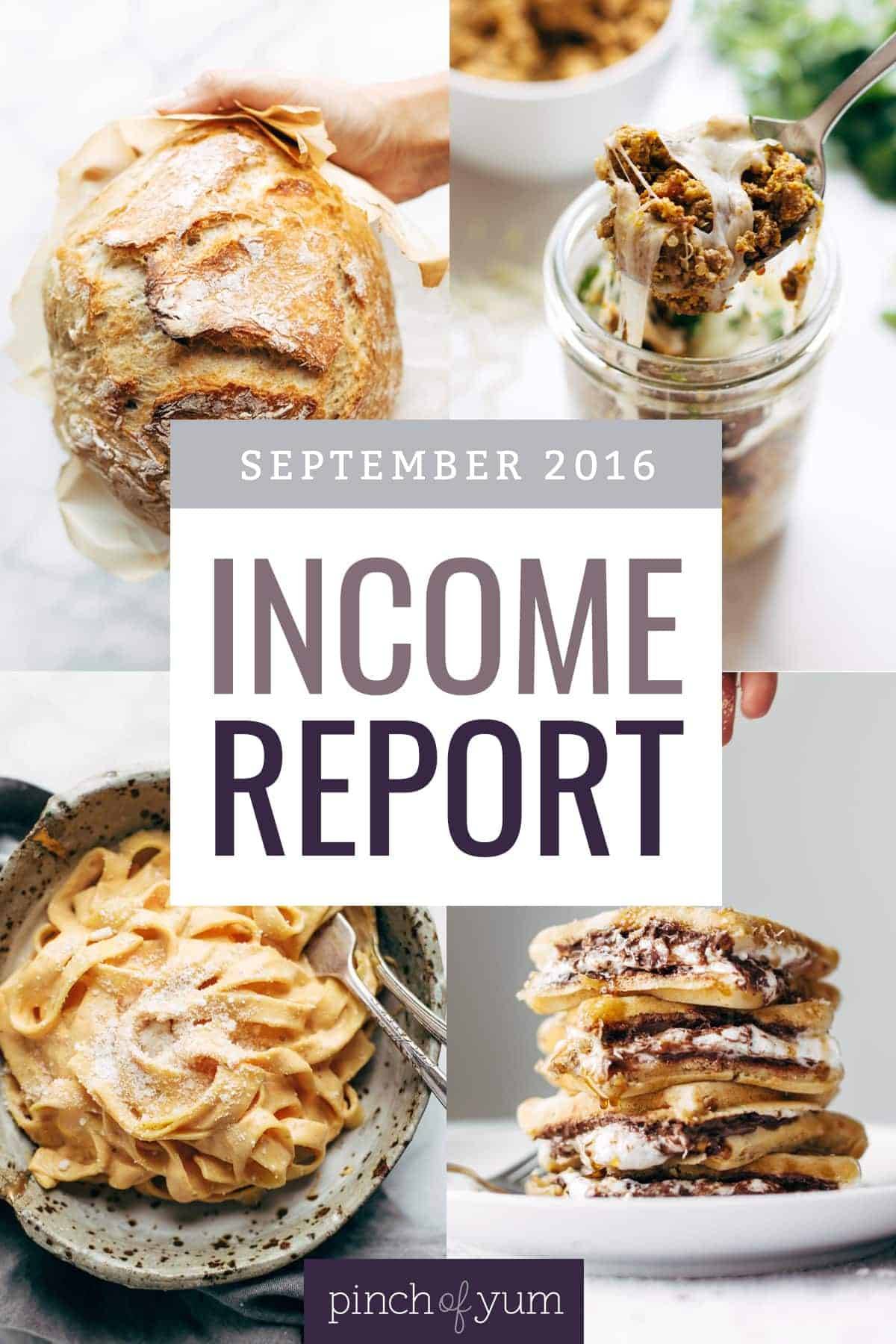
Hi there!
Bjork here. Checking in for the monthly income report here on Pinch of Yum.
We’ll look at three things in this report.
- September’s income totals
- September’s traffic totals
- September’s takeaway: Updating an Old Blog Post
We’ve been doing these reports for over five years now. The first time we ever published one of these was back in September of 2011, when we made a total of $21.97 and had almost (but not quite) 50,000 pageviews. You can check out that first income report here.
We’ve followed an insanely simple formula to get the blog to this point: Consistently doing the work and finding ways to do it a little bit better along the way.
Our key to success is showing up.
Not all the time. Not every single day. But almost all of the time. Almost every day.
Post by post. Picture by picture. Email by email. Year by year. Brick by brick.
A few years after launching Pinch of Yum we started another site called Food Blogger Pro. We followed the same slow and steady formula with Food Blogger Pro: show up every day and improve little by little.
Today FBP is a thriving community of over 2,300 members from all around the world. It’s truly an amazing group of bloggers and we’re deeply honored to be a part of it.
Note: We’re opening Food Blogger Pro for our Fall enrollment period really soon. Be sure to jump on the waiting list if you’re interested in joining.
If you’re starting and building your thing, whether it be a blog, a non-profit, or a new career, I’d encourage you to have a long-term mindset, show up every day, and find ways to enjoy the work.
Let’s take a look at the numbers for September…

Note: Some of the links below are affiliate links. All of the products listed below are products and services we’ve used before. If you have any questions about any of the income or expenses you can leave a comment and we’ll do our best to reply.
Income
- AdThrive – $28,553.61
- Tasty Food Photography Workshops – $5,765.00
- AdThrive Video – $4,072.10
- Bluehost – $4,025 –> this income comes from a page where we show people how to start a food blog in three steps.
- Amazon Associates – $2,653.80
- Swoop – $2,314.68
- Tasty Food Photography – $2,198.20
- Gourmet Ads – $1,428.44
- sovrn – $446.24
- Genesis Theme – $351.10
- How to Monetize Your Food Blog eBook – $225.00
- Elegant Themes – $139.00
- ActiveCampaign – $36.03
- AWeber – $14.40
Expenses
- Justworks and Contractors – $15,263.75
- New Computer + Equipment – $4,285.72
- Studio Related Expenses – $4,125.09
- Travel – $1,576.49
- Food Expenses – $1,309.36
- eBook Affiliates – $525.25
- ActiveCampaign – $415.00
- PayPal Fees – $282.35
- Photography Related – $271.43
- Software – $202.66
- Insurance – $131.91
- Education – $109.87
- Adobe Creative Cloud – $107.43
- EventBrite – $79.35
- Media Temple (Hosting) – $79.00
- Ceramics – $72.73
- LeadPages – $67.00
- Zapier – $50.00
- PayPal Website Payments Pro – $30.00
- Shoeboxed – $29.95
- Hotjar – $29.00
- E-Junkie – $28.00
- QuickBooks – $26.95
- Amazon S3 and Cloudfront – $26.53
- GitHub – $25.00
- VaultPress – $20.00
- CloudFlare – $20.00
- Pingdom – $14.95
- Backupify – $12.00
- Buffer – $10.00
- CrashPlan – $9.99
- Link In Profile – $9.99
- BoardBooster – $5.00 (Update: BoardBooster has shut down)
If you’re interested in learning more about some of the ways that you can monetize a food blog, we encourage you to download this free ebook, “16 Ways to Monetize Your Food Blog,” from our sister site, Food Blogger Pro!
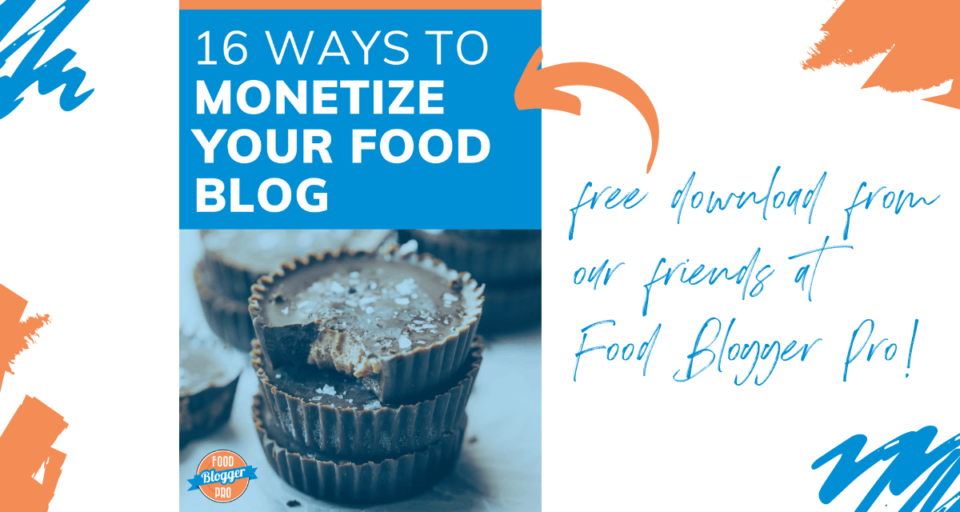
Traffic Totals
Below are some Google Analytics screenshots from the month of September 2016.
Traffic Overview

Top Ten Traffic Sources
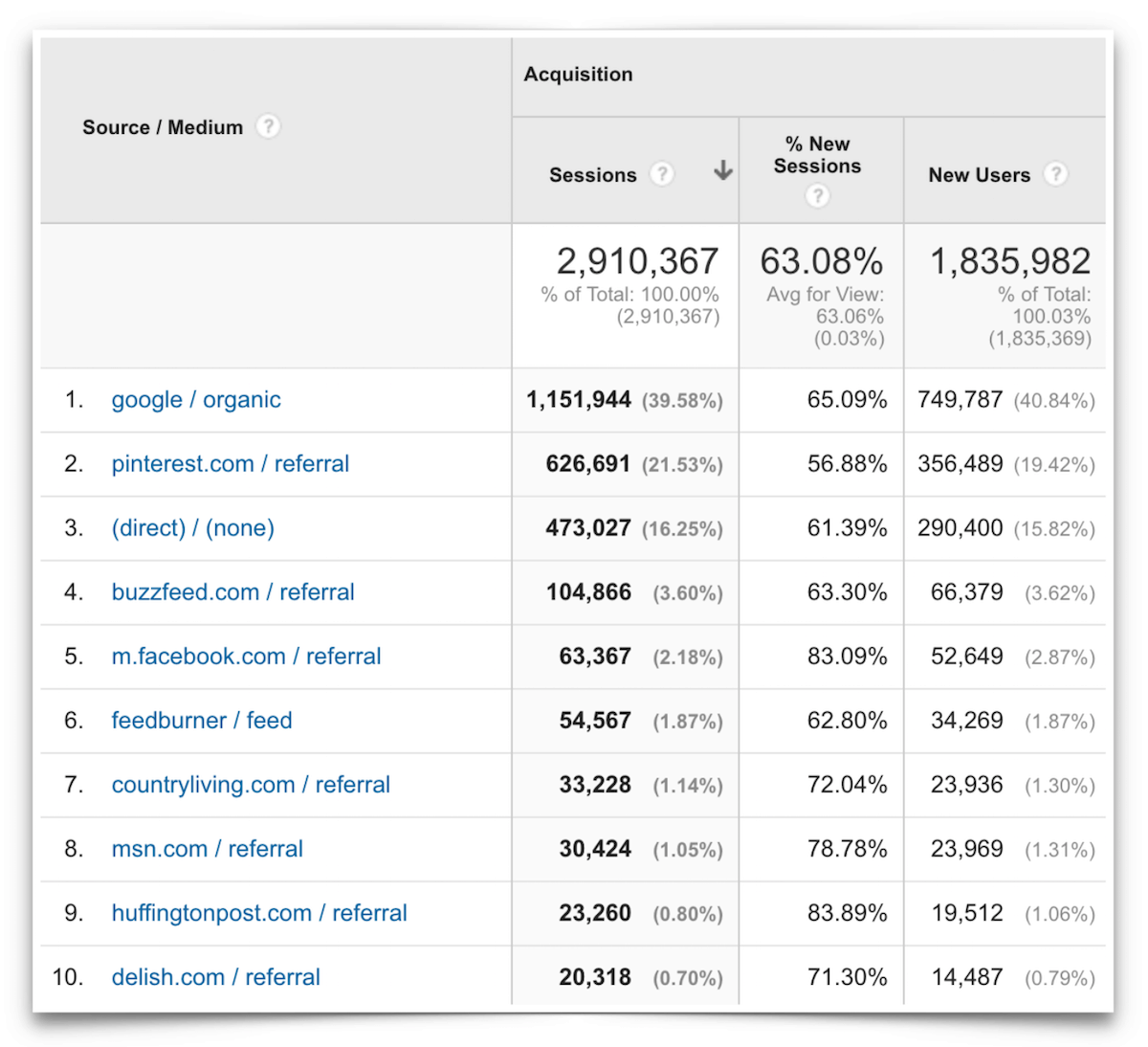
Mobile vs. Desktop vs. Tablet
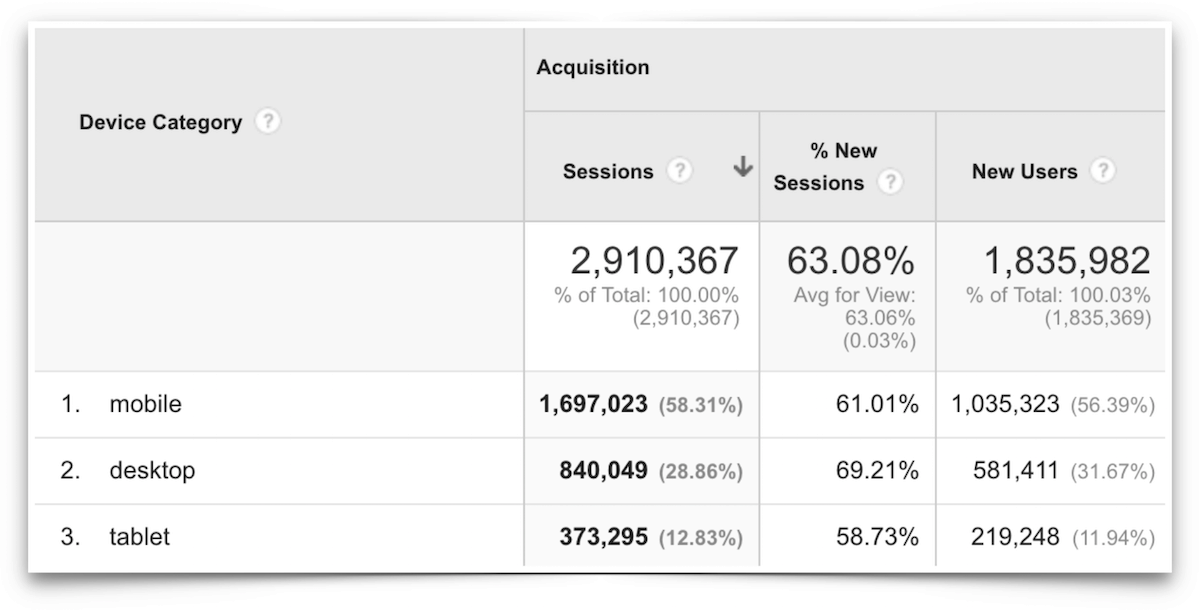

Updating Old Blog Posts
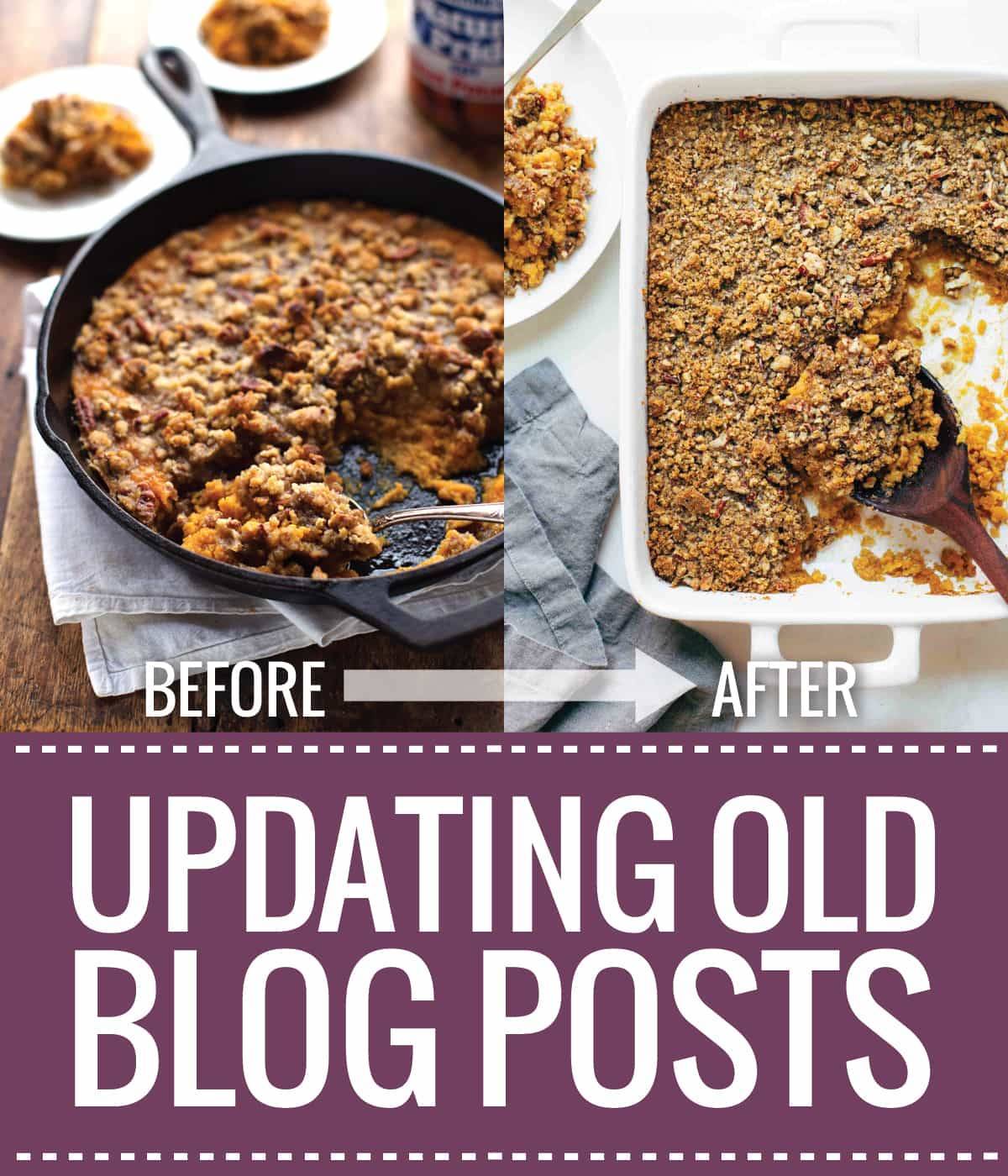
The takeaway that I wanted to focus on today is updating old blog posts.
Here’s the deal:
If you’ve been consistently blogging for a certain amount of time then you’ve probably built up a decent amount of content. For instance, over the past 6+ years of blogging Pinch of Yum has amassed 934 posts.
That’s a lot of content.
It’s one of the reasons why Pinch of Yum is able to get 4 million page views a month.
You often hear people talk (myself included) about the “secret” of success being consistently publishing high-quality content over a long period of time. It’s 100% true.
But it’s easy to get tunnel vision and only focus on creating content, all the while forgetting that it’s also important to update and improve your old content.
There are a few benefits to updating old blog posts vs. creating new ones:
- The new date will be updated in search results. This is a positive indicator for people that consider the date to be a factor in how relevant something is. Obviously this isn’t a huge deal with recipes (vs. tech news, for instance) and it only applies if you include a publish date on your recipe post.
- You can research old posts that are performing well (using Google Analytics) and double down on their success by exposing them to your audience again.
- It feels good to take a break from using the “create stuff” part of your brain and instead use “improve stuff” part of your brain. It’s good to switch it up every once in awhile.
- If you work with brands, you can connect with a brand that might be a good fit to sponsor the updated post. It’s sometimes easier to pitch a post that’s already been published (and will soon be republished) vs. trying to pitch a post that’s just a concept.
- You can feature seasonal content. You probably don’t have all the time you need to make all of the recipes you want for certain holidays or reasons. Instead of burning out on Thanksgiving food you can highlight some past recipes that you’ve already made.
- You get a chance to review the basic on-page SEO elements. We suggest using Yoast SEO for this.
- You can refine the keyword for the post. If you feel like the original keyword you used (or maybe you didn’t use one at all) was off then you can update it to something relevant and targeted.
- The biggest benefit? Increased traffic to the post. It’s not a guarantee, but we found this to be true when we tested this out at the beginning of the month. See below for more details. 🙂
At the beginning of October Lindsay updated this sweet potato casserole recipe.
It was a pretty big update, including new photos, a recipe video that Alana and Krista created, some additional written content, and updating some of the SEO metadata (using the Yoast SEO plugin I previously mentioned).
If you’re updating an old post you don’t have to do a big overhaul as we did for this post. Even small changes like updating the SEO metadata and adding in some new (and relevant) written content can help.
Lindsay also worked with a brand that sponsored the republished post (it wasn’t previously a sponsored post).
The Results From Updating An Old Blog Post
The proof is in the pudding, er, sweet potato casserole…right?
Here are the results from updating and republishing that post.
Traffic
Here’s a screenshot of the overall traffic to this post from the past 30 days.
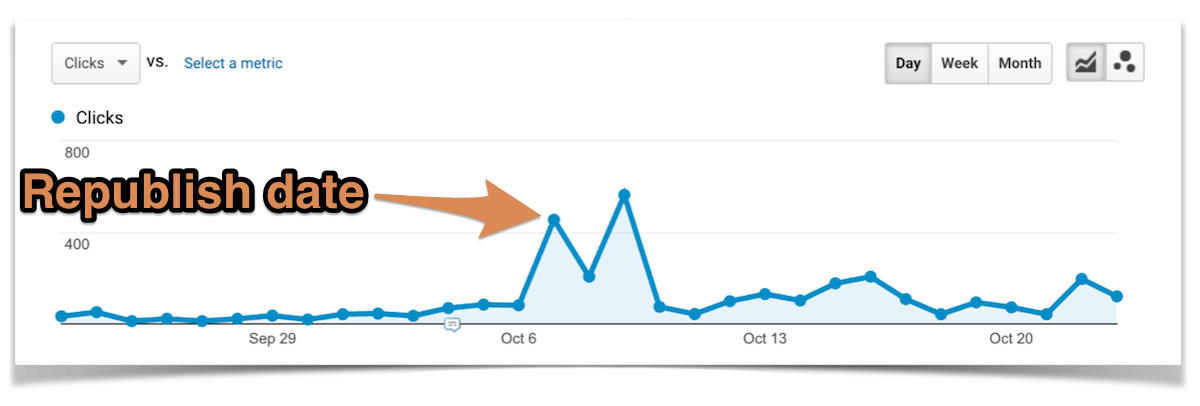
And here’s a few screenshots comparing traffic from the week before we updated the post and the most recent week of traffic.

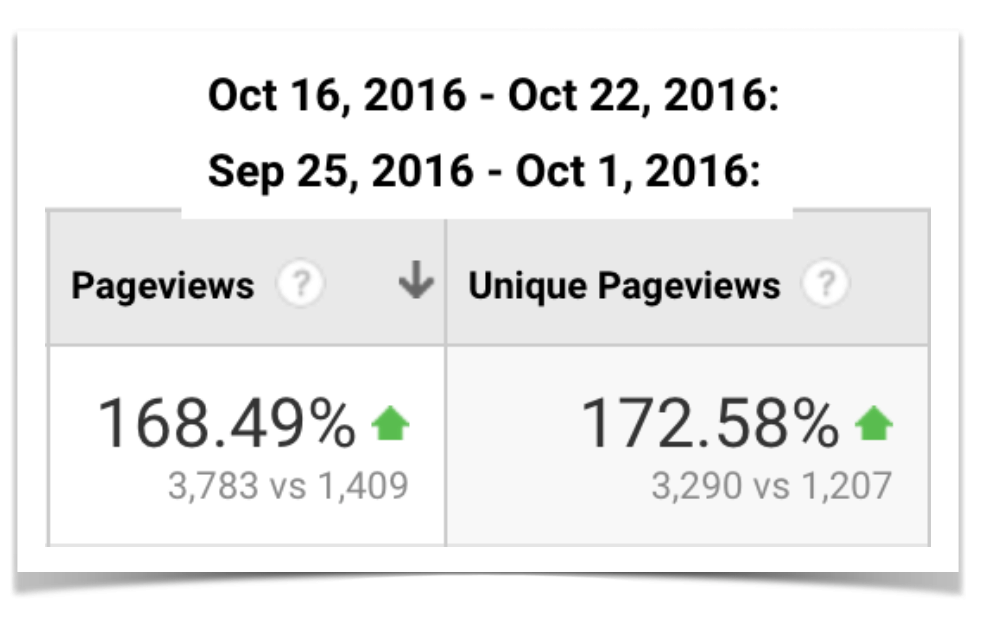
Search Position
So the experiment was a success, right?
Well, not so fast…
Straight up traffic stats aren’t exactly a good metric to use when gauging whether this was a successful experiment or not. Here’s why: It’s possible (and likely) that we’re getting more traffic because republishing the post simply resulted in more people finding it because it was more prominently displayed on the blog. Or, perhaps we’re getting more traffic because it’s close to Thanksgiving, so more people are making this recipe.
A better metric to look at is the Search Analytics area in Google Search Console.
Specifically, I’m looking at the Position report for the query sweet potato casserole recipe.
This handy little report shows us the average position on a Google search results page for certain search queries.
If the number is 10, that means that this post, on average, shows up as number 10 in Google search results for the term “sweet potato casserole recipe.”
As you probably know, higher is better.
Here’s a screenshot of the before and after for republishing the post.
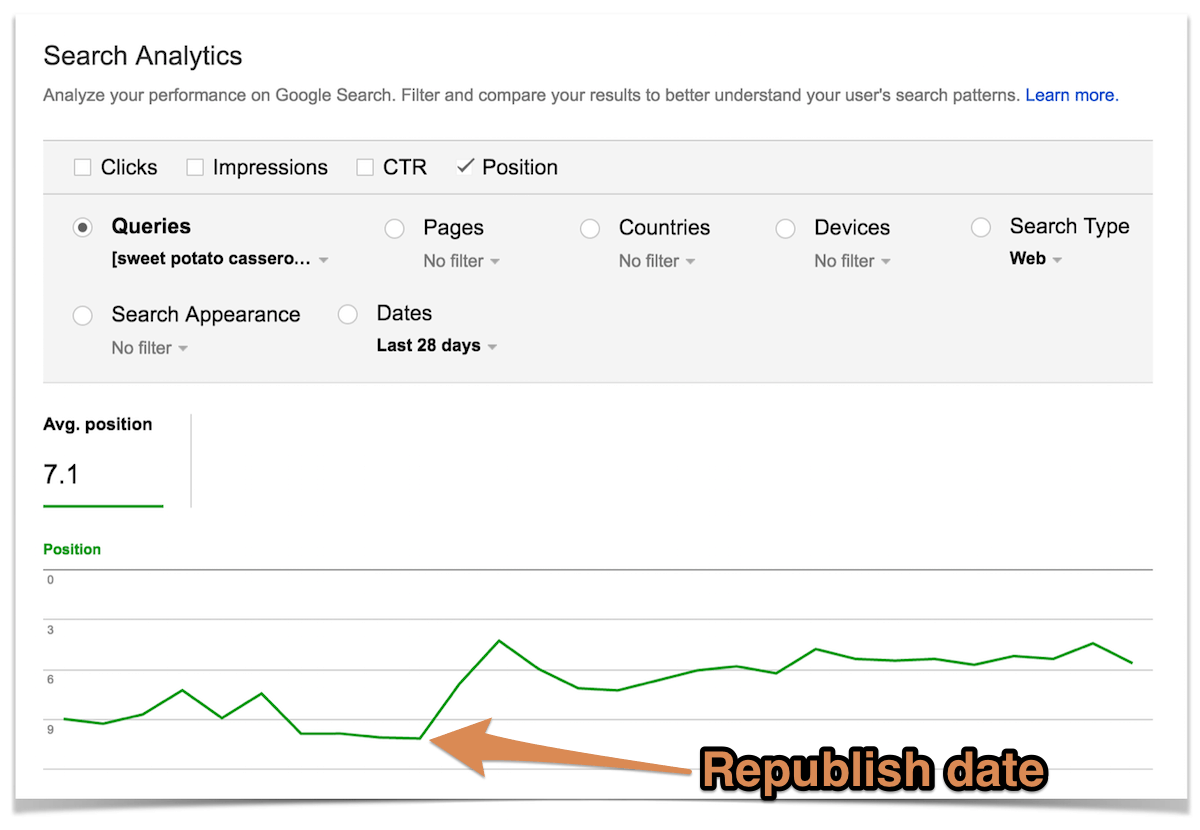
Pretty interesting!
So does that mean that be republishing and updating this post resulted in it showing up higher in Google searches?
In a word, yes.
We saw a consistent and steady lift for three days after republishing that post. After that, it came back down a bit but then slowly started going up again.
It’s an exciting graph to look at (at least as far as graphs go) because it shows pretty clearly that updating and republishing that post resulted in a boost in its position on search results pages, which almost always results in a boost in traffic.
The process is pretty simple:
- Update the content by finding ways to make it more valuable (better photos, a better explanation of the recipe, updated metadata)
- Change the publish date and hit update.
Two quick things to consider if you do this:
- If you’re changing the URL (like we did) then you’ll need to make sure and redirect the old URL to the new URL. We use a plugin called Pretty Link to do this. If you’re technical you can jump into your blog’s .htaccess file and manually do that redirect.
- If the republish date you pick results in the post being the most recent post on your blog then your RSS-to-Email campaign (if you have one set up) will probably send out an email to your subscribers. This isn’t necessarily a bad thing, but it’s something to be aware of.
The two tools you’ll need to do the tracking for this are Google Analytics and Google Search Console, both of which are free (and incredibly powerful).
There cheers for tasty and (re)fresh(ed) recipes!
Because of You
It’s because of you that this thing we call Pinch of Yum can exist as it does today. Thank you so much for making these recipes, leaving comments with your love and feedback, sending emails, following on social media, and sharing this food around the table with your families and friends.
Every month we donate a portion of Pinch of Yum’s income to non-profit or foundation that’s near to our heart. This month we’re donating to the Children’s Shelter of Cebu and helping to fund their budget for daily meals.
